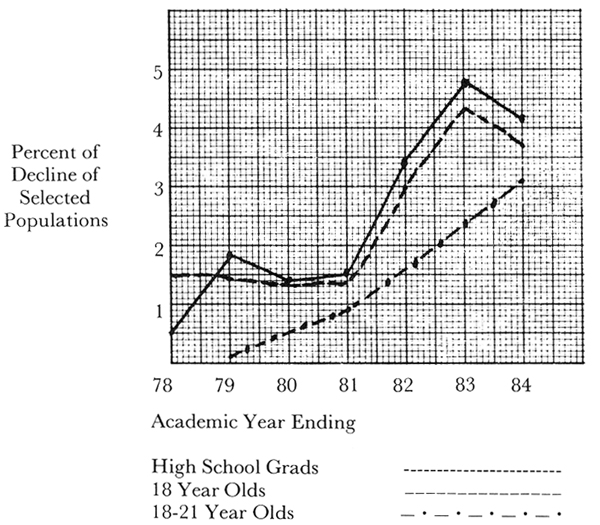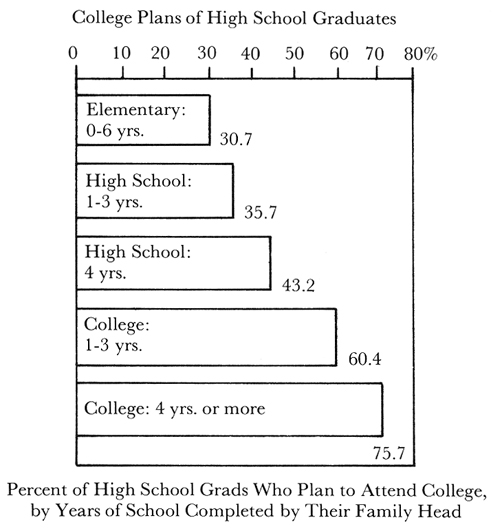Almost daily the media are reporting on the prospects of reduced budgets and enrollments in colleges across the nation. If these forecasts are correct, many college music faculties are facing rather unpleasant and uncertain futures. In the face of these dire predictions, the profession must take action to maintain its status and build for the future. How can these goals be attained? Part of the answer is in the ability of a college music faculty to recruit and retain students. No longer can professors rest on their tenure and leave the recruitment of students to persons outside the music profession. It is, therefore, the purpose of this article to offer some suggestions on the establishment of a recruitment process within a music department.
A general review of current population projections certainly removes any doubts regarding the necessity of establishing a recruitment program. Recent Bureau of the Census data predict rather significant declines in the prime college age group populations as indicated in figure A.
FIGURE A

Furthermore, data from the U.S. Office of Education and the Census Bureau project population peaks of: 3,148,000 for high school graduates in 1976-77; 4,236,000 for 18-year-olds in 1977; and 16,900,000 for 18- to 21-year-olds in 1978. After the crests, declines in these groups are expected to continue through the academic year 1983-84. This information confirms that expanding enrollments have ended. Fortunately, fine and applied arts and music have recently enjoyed enrollment gains of 1.6% (1974-75) to 2.4% (1975-76). This happy circumstance has tended to reaffirm music as a valuable viable curriculum offering.
Additional statistics from the Bureau of the Census indicated that during the years 1972-75, approximately 45.4% of the high school seniors planned to attend college. This material has also revealed that high school seniors most likely to attend college are those from households where their family head has attended college. There is a definite relationship between college attendance and the number of years of education completed by the family head of these prospective students. This is confirmed by the data presented in figure B.
FIGURE B

This information tends to indicate that recruitment of students will accomplish both current and future enrollment goals. By maintaining enrollment levels, through an effective recruitment program, a constant number of college graduates will be maintained. These graduates, according to figure B, tend to be our most effective recruiters, and could indeed make acceptable enrollment levels self-perpetual.
Musicians might look to the most successful student recruitment program in our colleges. Many athletic programs have had the good fortune to receive rather large budgets to recruit for their activities. Why? Despite the glamour generated by intercollegiate sports, athletic departments have proven their ability in attracting students for their programs and institutions. Athletic departments long ago learned that the successful program is directly related to an equally successful recruitment process. Far too few music departments can rival athletic departments in this endeavor. It is the opinion of this writer that college music faculties do indeed have the ability to make indispensable contributions to the college-wide recruitment process. A recruitment program must be established, and the goals of this program must coincide with the recruitment objectives of the college.
A major step in developing a viable recruitment program is the designing of a departmental brochure. This brochure should be attractive, easy to mail, and provide information about the department and the institution. In addition to listing courses of study and catalogue offerings, brief resumes of the faculty should be included. These departmental brochures can be mailed annually to all secondary school music departments in the college's service area. Furthermore, the brochure is a very handy inexpensive source of information to provide for prospective students, parents, and the college admissions office.
It is extremely useful to have a recruitment committee in the music department. Within this committee (sometimes in small departments a committee of one), someone must assume the responsibility for co-ordinating the recruitment efforts. This person must feel comfortable in the role of "recruiter-in-chief" and be willing to visit with prospective students, parents, school administrators, and teachers both on and off campus. The personality of this person will, to a large degree, determine the success of the program. It must be pointed out to the college administration, in many instances, the necessity of designating a member of the music faculty to assist in the college-wide recruitment effort. Only a music faculty member can give honest complete answers to prospective students, parents, and others. Many times, the queries of students and parents are of a vocational nature. Why should one study music or participate in ensembles? What are the vocational opportunities for music graduates? Obviously, only a person in the profession can give adequate answers to these and other inquiries. Additionally, the recruitment process affords the music faculty an opportunity to participate in the advisement process. Unfortunately, a number of college prospects have received poor or no advice regarding their future college careers. Good academic advisement can both recruit and retain students by avoiding misunderstandings and other difficulties students might encounter after enrollment in college. It is also recommended that the aid of music students be enlisted in the face-to-face recruitment process with visits and phone calls to prospects. Carefully planned tours and off-campus recitals are very helpful too.
Recruitment of college musicians usually cannot be confined to attracting solely music majors. In many college music departments, it would be difficult to maintain acceptable enrollment levels in classes or balanced ensembles with purely music majors and minors. Besides, it just might be that the oboe player or tenor voice at a local high school is determined to major in chemistry. Recruitment of college musicians, therefore, rarely can be confined to attracting only majors. There are many excellent performers who will participate in ensembles and take courses, but not major or minor in music. Why not attract this talent for your department?
In order to have an ongoing recruitment program, a standard procedure or routine must be developed. After a list of contacts (prospective students) has been obtained from the admissions office and other sources, the process begins. The list of contacts should include the name, address, and telephone number of each student. An aggressive recruitment program will strive to expand its list of prospects with the aid of faculty, students, and alumni. Upon receipt of such a list, each prospect should be contacted first by mail. Since it is impossible to have a complete list of prospects prior to any registration, the roll of prospects will, we hope, enlarge with the passing of each month during the academic year. Initial mailings might be personalized letters giving general information about the department and its programs—an expansion of some of the data on the brochure. Each letter must be typed individually and signed by a faculty member. This technique adds a personal touch and gives the prospect a "contact" on the music faculty. Often "personal" communications produced by a duplicating process are discarded. Several weeks after the first mailing, send the prospect a copy of a recital program and the department brochure. This second mailing will probably occur early during the spring term. Next, it is helpful to send another "personal" letter with a stamped, self-addressed post-card. Ask the prospect to give some specific information (viz., proposed major, performance specialties, etc.) and mail the card. The number of returned cards will indicate to some degree the interest a prospect has in your college. Remember that these prospective students, especially the very talented ones, are being contacted by other institutions. In addition to regular mailings, it is most helpful to telephone the prospects and to endeavor to meet them personally at music festivals, auditions, orientation, or registration. The earliness of the initial contact and the frequency of later ones may well determine the success of the recruitment effort. The preceding process is a great deal of work and effort, but it usually brings good results.
Normally, the off-campus recruitment process will be confined to the recruitment of secondary school graduates for the undergraduate program and holders of the baccalaureate degree for the graduate school. The recruitment effort, however, should not be limited to only these groups. It is very desirable to develop an on-campus recruitment process as well. In all probability, there are many talented musicians on your campus that would take advantage of offerings in the music department if they only knew about them. How can these students be recruited? Perhaps the best method is to have a very visible music faculty. It is incumbent that all music professors climb down from the podium and mingle with the masses. In addition to performing regularly in faculty recitals and presenting scholarly papers, professors should participate in and attend various co-curricular activities on the campus. Frequent visits to the student union will develop numerous on-campus friends (contacts). It is good for students to see and talk to professors outside the classroom. Much can be learned about your college through informal conversations with students.
Finally, the music department must collect data on its recruitment process. This information is necessary for the formulation of future strategy, refinement of the process, and continuity. Recruitment is a long-term procedure. Numerous questions must be constantly answered. Some are: What percentage of the total college enrollment participated in music activities in secondary school? How many of these actually come into the music department for classes or ensembles? Who are they and where do they come from? Why aren't students with previous musical training coming to the department? Is there something wrong with the instruction, curriculum, or schedule? Sometimes, students do not take advantage of music offerings because of poor scheduling. Why are students leaving our campus? A poor retention rate may be the result of non-academic problems, e.g. living conditions, financial aid, etc. If the department knows the answers to these and many other questions, good planning for a successful recruitment program can be accomplished.
Despite the dark clouds on the horizon of academia, there are actions that music faculties can take to maintain the profession. Moreover, recruitment of college musicians will tend to improve relations with colleagues in other academic areas, administrators, and trustees. This is a large nation with many qualified music students graduating from secondary schools and colleges each year. It is, therefore, necessary for music faculties to convince these talented individuals to attend or continue in college to further enhance their musical and academic skills.


